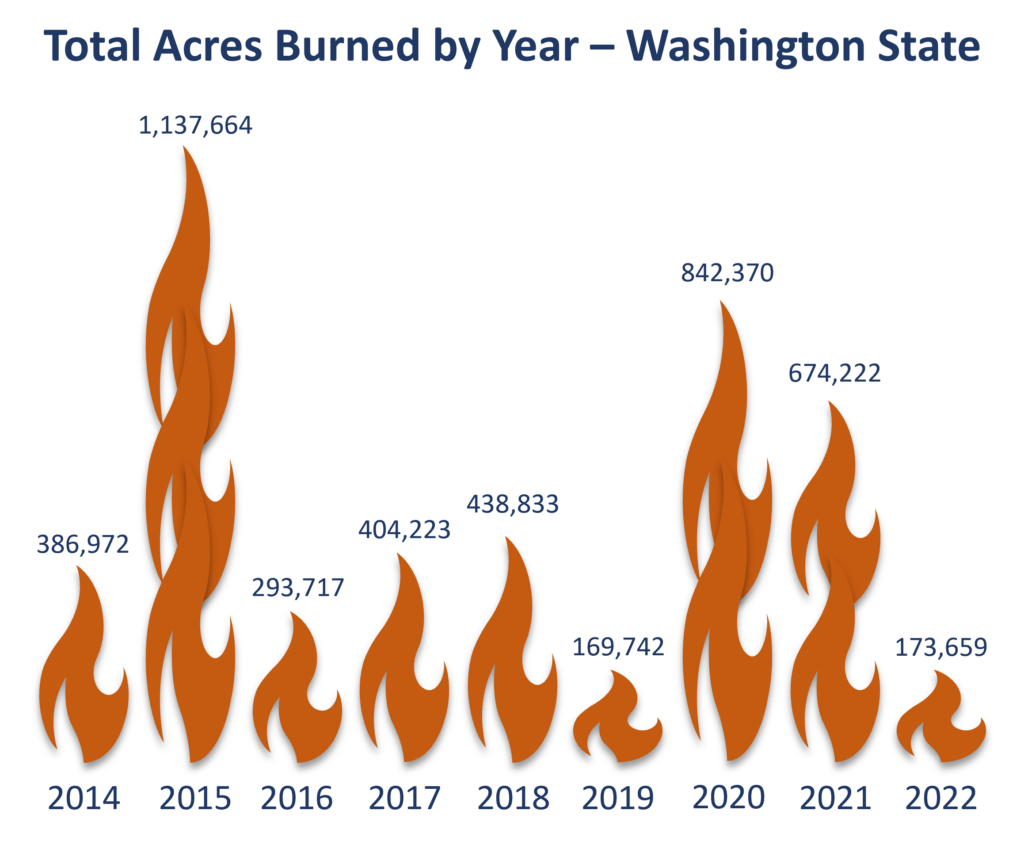- All Posts
- Fires and Flooding: The Impact of Environmental Disasters on Resiliency Infrastructure in the PNW
Fires and Flooding: The Impact of Environmental Disasters on Resiliency Infrastructure in the PNW
Authored by Jason Twill, LEED Fellow
In 2023, the Canadian Interagency Forest Fire Center (CIFFC) reported a total of approximately 18.4 million hectares (45.4 million acres) of land burned during the wildfire season. While these fires mostly affected only Canadian territories, smoke does not recognize fire lines or national borders and the air quality within the Pacific Northwest was greatly affected. Mornings that would normally be sunny instead were gray and warnings went out for those with breathing issues to be aware of their time outdoors. This unfortunately is becoming a normal summer occurrence for the Pacific Northwest in addition to the regional wildfires that occur yearly. When combined with the increasing effects of atmospheric rivers and increased flooding, building owners and municipalities in the Pacific Northwest are in urgent need of resilient infrastructure and land management to mitigate the effects on their community members.

The Pacific Northwest contains approximately 140 million acres of public and private rural and forested land, all of which is at risk for potential catastrophic impacts of extreme weather and the potential affects that can occur from it. Croplands and pastures at the mercy of droughts and flooding, forests and grasslands for wildfires. No matter what the cause, the communities that surround and depend on these areas are vulnerable. Wildfires are causing residents to lose their homes and forcing evacuation at the worse times; the smoke generated from these fires put those with respiratory illnesses at higher risk for hospitalization, some people having to go as far as secluding themselves at home during times of poor air quality. While all this alone is enough to make anyone question what they can do to aid in prevention of these issues, when combined with the effects on the physical landscape and infrastructures of communities, another critical weather and environmental terror becomes even more detrimental – flooding.
While fire and water may normally be opposing elements, for many in the Pacific Northwest, the two can lead to a damaging year of lost homes, destroyed businesses, and ongoing health concerns. As wildfire season ends every October, the damage left behind including lost vegetation, soil erosion, and debris, remains. While some environmental impacts be addressed and repaired, communities who cannot repair all impacted areas are at greater risk for the potential of increased damage from flooding that comes with increased rain and atmospheric rivers, the latter of which are likely to continue in both intensity and frequency.
Due to the soil erosion and affected drainage patterns, community watersheds that normally divert water to specific areas can be damaged, causing runoff to move towards areas that contain critical infrastructure for communities. When looking at debris, blockages and changes in terrain can cause landslides or further flooding, both of which can create a cycle of destruction that some communities may never recover from, particularly in less-affluent communities. But what can be done to create better preventative systems to help avoid the negative impacts by these inclement issues? The best solutions are found in strategic infrastructure development and changes.
For many of us, the ability to control the weather and effects of are a wonderful dream, but unfortunately, just that. To counteract this lack of superhero ability, more and more facility owners and municipalities are choosing to turn towards impactful infrastructure changes instead. While these changes vary heavily depending on the facility purpose and communities they reside within, when looking at wildfire and flooding mitigation, there are some changes that apply to the many easily.
Some of the most impactful infrastructure changes regarding wildfire impact is updating HVAC systems within buildings to better combat smoke and poor air quality. By updating with newer, smarter technologies and systems, buildings are becoming better at responding to changes in the air quality and adjust accordingly. Additionally, many of these new systems are designed to self-report, letting facility maintenance teams know well ahead of time when maintenance and repair is needed, allowing owners to always be properly prepared. When looking at flooding mitigation, owners are evaluating their facilities to see how flooding could affect operations and user needs, such as hospitals moving critical infrastructure equipment like generators to higher levels of their buildings to reduce the chance of damage. No matter the facility type, Pacific Northwest owners and facility operators are seeing the change that can come and protection that they can provide to their communities through updates that can be simple when working with the right team.
One of the hardest milestones we at Viridis see for our clients is finding a project team they can feel confident working with who has their goals as the first priority. Our team has heard time and time again that for many owners, the struggle of partnering with the right team can delay or sometimes even cancel infrastructure projects that could be critical to their resiliency as both a facility and community member. By bringing in teams like Viridis Initiative who not only understand the nuances of every step of planning, construction and performance, but also make it part of our mission to know exactly what challenges owners are facing, projects run smoother, end in better results and meet the mission of owners. We encourage anyone to reach out to our National Practice Leads to find out how Viridis can help you prepare your facilities for the worst, while creating the best project possible.